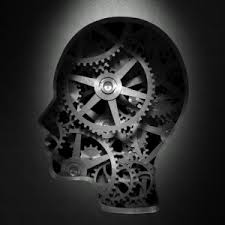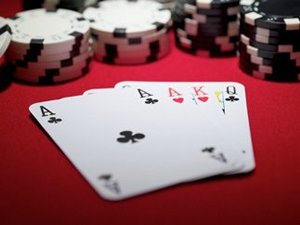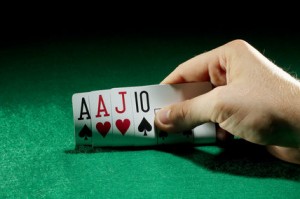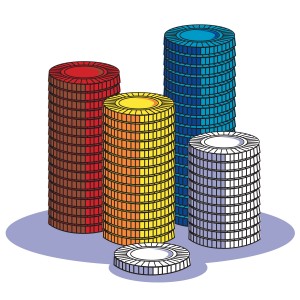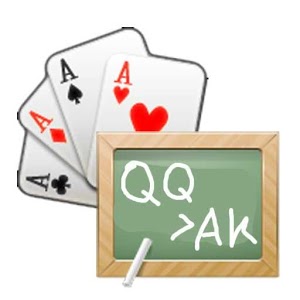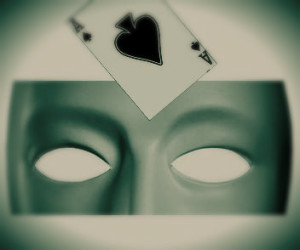Perhaps the biggest reason why people lose money at poker is tilting. And perhaps the biggest reason for tilting is having unrealistic expectations. Many omaha high/low players live in a la-la land, a land of boundless optimism that knows no statistical limits. When the flop, the turn, or the river “ruin” their “premium hand”, sometimes people go nuts. “Not me again!” I think this can be prevented by adjusting one’s expectations with reality. In this article, we will look at some typical situations in omaha high/low and their accompanying expectations.
The Flop Expectations
What can you reasonably expect from the flop? On average, how many times will the flop favour high hands and how many times will it favour low hands?
Mathematical distribution tells us that the flop will be all-high (all cards 9 to K) only about 5% of the time. In this case you know that there cannot be a low (even if the turn and the river are low cards, you are still missing another low card). The flop will have one low card about 32 % of the time. This means that if you have a low draw, it will be completely worthless about 5 % of the time (about 1 in 20) and worth very little about one third of the time (about 1 in 3). No, God or life does not hate you. This will happen with regularity. Expect it. We all want to see flops that match our hole cards. But this is statistically unreasonable. The truth is that the flop will “screw up” your low draw about 37% of the time. The goods news is that it will contain two or more low cards about 63% of the time. In other words, the flop is more likely to be a “low flop” (have two or more low cards) than not. But the margin is not as huge as one would like with a low draw. You will flop a playable hand most of the time, but you will also have to fold often if you are drawing only to the low side. By the same token, you will not flop a playable high hand most of the time, yet it will happen with a reasonable frequency. Note that in either case, the flop merely follows statistical expectation. When it does not match your hand, no matter how good it initially appeared, this is not “bad”. Some players invest the game with feelings that have dimensions of a Shakespearean tragedy. This is not only absurd but positively harmful to the quality of your play.
The Turn and the River Expectations
Consider the following classical scenario. In the hole, you have As 2h Th Jc. Suppose the flop is 3c 8c Kh. With what regularity should you expect a low card to come on the turn that does not counterfeit your hand but makes your low? Clearly, the choice is limited to all 4s, 5s, 6s, and 7s. That’s 16 cards. There are 45 unseen cards (52 minus 7). So 16 out of 45 cards will make your low on the turn. That’s about 36 % (little more than 1 in 3). In other words, you will not make the low on the turn in this situation most of the time. Now suppose that you missed the turn and it came out high. How often will you make your low on the river? Clearly, 16 out of 44 cards will help you. That’s somewhat over 36 %. So again, you will not make the low on the river in this situation most of the time. Of course, the combined probabilities of making it on the turn and on the river make it more likely than not that you will make it by the river. But considered separately, it is more likely that you will not make your low either on the turn or the river than that you will. Prepare yourself emotionally for that.
Lastly I want to address the high draws. Here the question is usually about the river card. Consider the following typical situation, involving a flush draw.
Your hand: Ks 2d 3h Js
The Board: As Jh 7s 6c
You have a premium hand. You will win the low, unless you will be counterfeited on the river (there are 6 cards that can counterfeit your low. That’s 6 out of 44, which is about 14 %. Not very likely but it happens) or by other players who also hold a 2 and a 3. How likely is it that you will make your flush on the river? 9 out of 44 cards will make your flush. Since we don’t want the board pairing (it can easily make somebody else’s full house), it is a good idea to discount 6 of spades. So 8 out of 44 cards will give us the high nuts. That’s about 18 % of the time. Considering that we don’t want the low counterfeited, the only “perfect” cards that can come on the river are: 4s, 5s, 8s, 9s, Ts, Qs. That’s 6 out of 44. In other words, the river will be perfect for you only about 14% of the time!
These expectations should be helpful in keeping your imagination in line with reality. It’s a numbers game. Don’t be unreasonable. Don’t live in a la-la land. It’s expensive.
Submit your review | |

